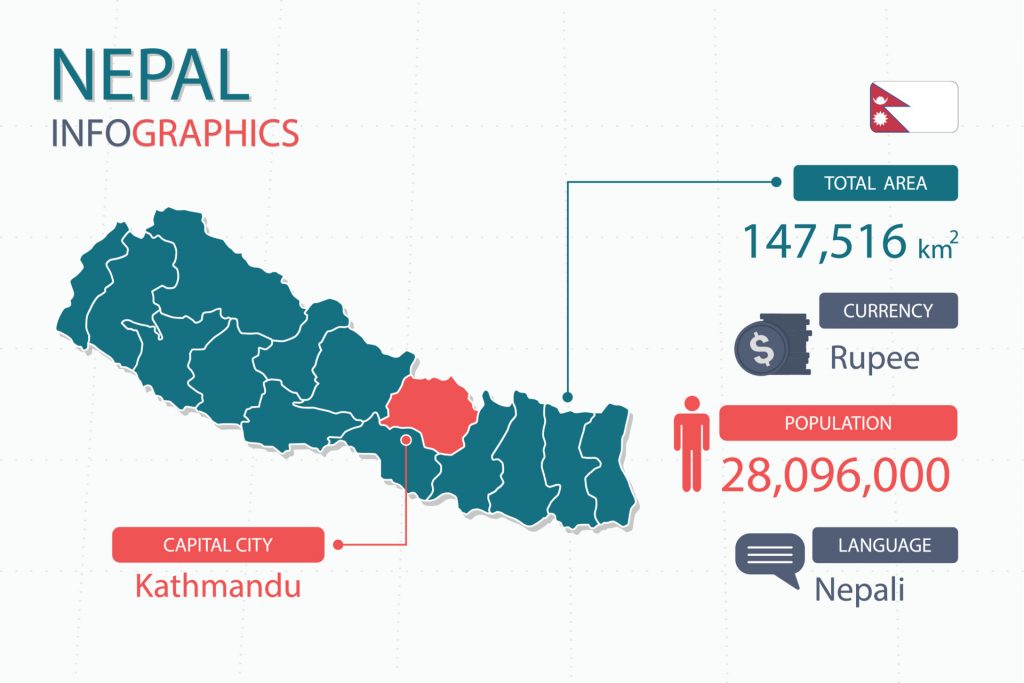The origins of the Nepali Language
Nepali language is a language mainly spoken in Nepal. However, it is also one of the 22 official languages of India, primarily spoken in the state of Sikkim and in the Darjeeling district of West Bengal. When ordering a translation it’s vital the translation agency know if they should Translate for Nepal or Nepali for India.
Moreover, it is spoken by a large number of ethnic Bhutanese and Burmese. It has about 17 million native speakers, with about half the population of Nepal using it as a native language. We are able to provide Nepali translation for Nepal as well as Nepalese translation for India.
As Nepal is the origin of the Nepali language, factors due to geographical and cultural circumstances shape its history and development. With its proximity to the Tibet region and to Burma, it has been influenced by the languages associated with those areas. However, in terms of language geneaology, it is widely considered to have stemmed from Sanskrit and to have developed alongside the Pahari languages.
Grammatical features that distinguish Nepali from other more common languages include postpositions and a pronoun system that distinguishes between three levels of formality. This is in contrast to languages such as Spanish and French where there only two levels of formality are distinguished, usually by a formal pronoun and a familiar pronoun. In Nepali, pronouns can be low, middle, or high for second-person and third-person pronouns. In addition, for the third person, one differentiates for physical distance as well. In terms of a more literal translation, this may be translated to “he over here” as compared to “he over there”; there would be separate pronouns for these two concepts. However, there is no differentiation for gender. Verbs are also inflected for number, gender, status, person, tense, mood, and aspect. This characteristic is one that is found in many European languages as well.
Nepali is written using a script called Devanagari, which is an abugida. In such a system, the consonant-vowel combination is written in one unit that contains a consonant letter and a vowel notation. It is written from left to right. The same Devanagari script is used in a variety of other languages as well.

Many historians and Nepali language translators believe that the Nepali language descends from a language spoken by the ancient Khas people, which stems from Sanskrit. These people occupied territory in parts of modern-day Nepal, India, and Tibet. The Khas people separated into separate communities and kingdoms, which notably included the Gorkha Kingdom. Gorkha replaced the original homeland of the Khas and the name Gorkha became heavily associated with the Khas. At the same time, the name Nepal was heavily associated with the region in general. There is heavy debate as to where the name actually stems from and various theories exist. Due to conflicts with local powers, including Muslims, British, and Chinese, the Gorkha people eventually settled in present-day Nepal and the language spoken by them was used as the lingua franca in the region. Eventually, the Kathmandu Valley in which the Gorkha was located became a political center of administration, and as the name Nepal was associated with this area as well as with the people, the name slowly caught on in usage. In the early 20th century, Gorkhali, the name of the language spoken by the Gorkha people, was changed to Nepali to reflect the name of the region, and this was the adopted named of the language.
Throughout its history, Nepali language has been influenced by many languages and cultures due to its location, especially between India and China, with Indian, British, Chinese, and Tibetan influences throughout the hundreds of years. Thus, there are many loan words that have Tibeto-Burmese origins. In addition, there is some Arabic, Persian, and English influence well. The English influence is due to the previous British educational and scientific support.
Currently, Nepal has an impressive history of literature, especially after Nepali became the national language of Nepal in 1958. The period between 1960-1991 especially is recognized as one of significant importance in the development and evolution of Nepali literature. A variety of genres of literature were written including short stories, plays, and poets. In the period after the Democracy Revolution of 1991, more Nepali language literature was written. In addition, there is a large number of literature that originates from the Nepalese diaspora from around the world, and not just from Nepal. A literature tradition of such a wide range has impacted the development of the Nepali language as well.
Interestingly, Nepali may not be considered a dominant language in Nepal due to Nepal’s diverse linguistic heritage. 44.6% percent of the population speak Nepal as a native language, which is a large percentage compared to the other languages if the other languages are considered separately, but Nepali functions more as a lingua franca. Local varieties are spoken among the different communities that exist. In the 2011 national census, there were 123 Nepalese languages that are spoken as a mother tongue, ranging from Hindi to Urdu to Sanskrit. All the local languages spoken in Nepal are considered national languages, but the official language used for government and education is Nepali. Each province, though, can choose one or more other languages spoken by the majority of its population for government work.
VEQTA can provide you with a perfect Nepali translator for your Nepali translation, English to Nepali translation and Nepali to english translation for the your targeted locale. Our translations to Nepali are created with your target audience in mind to meet your expectations.
If you need to translate Nepali – Get in touch today!
A dedicated team of Nepali translators who combines Experience, Specialized Subject Matter Expertise with best Translation Practices to deliver quality second to none.
Nepali Subject Expertise
Nepali Translators
Nepali Editors
Nepali Copywriters
Nepali Reviewers
Nepali Voice dubbing
Nepali Subtitling
Nepali Transcription


